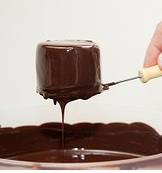
If the popularity of Mast Brothers proves anything, it’s that we’re all suckers for pretty packaging.
But when you’re gearing up to sell your first box of chocolates, making wholesale packaging choices can seem really daunting. The options seem endless. And not only for packaging… You’ll be making choices about graphics, about liners, about trays, seals, labels… decision after decision. It’s overwhelming.
The following guiding principles will help you make choices you won’t regret later.
First, consider your brand.
For example, you might ask yourself:
- Are my chocolates elegant or rustic?
- Are my chocolates priced to be high end treats or everyday indulgences?
- Does my business have a theme, and if so, how can I incorporate that theme into my packaging? (For example, if you’re known for bonbons with unusual flavor combinations, consider boxes as playful and creative as your flavors).
 And here’s an anecdote from my own life.
And here’s an anecdote from my own life.
My chocolate bourbon truffles (pictured) are elegant and modern, with clean lines and geometric patterns (thanks to my trusty transfer sheets), so I guess I could have packaged them in elegant boxes with shiny foil liners.
But… refined packaging is not my brand.
How did I know that? Well… I dip each of my chocolates by hand. I’m proud to use chocolate from a local small-batch chocolate maker. I steer clear of artificial ingredients and preservatives.
So I was looking for packaging that suggests my chocolates aren’t just pretty sweets to be mindlessly eaten. My packaging needs to make it clear that these are high quality, individually produced treats, made entirely by one person from simple, wholesome ingredients.
My packaging needs to feel PERSONAL. Because my chocolates are personal.
With that in mind, I chose simple craft paper boxes, each one tied with twine.
The resulting packages are modern, rustic, and elegantly simple. Just like what’s inside them.
Second, consider what packaging will best protect your chocolates during transit.
If you plan to ship your chocolates, you’ll need strong boxes, perhaps with plastic trays to keep each chocolate in place, and a protective foam layer under the lid. And you’ll need to seal your boxes well and stamp them with a sell-by date.
But if you’re hand delivering chocolates to a friend as I did, you can skip the trays entirely, opting instead for simple brown paper liners. Layers of gift tissue should keep the chocolates from moving around too much.
They won’t be sitting around long at your friend’s house, so no need to worry about an expiration date on these babies. 🙂

Btw, I bought these boxes and liners on amazon, but wholesale packaging distributors are cheaper and offer a wider variety of customizable packaging. Shoot me an email if you’re looking for wholesale confectionary packaging distributors — I’d be happy to send you a few names.






















